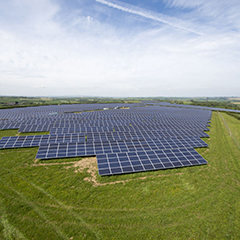Munich/Pforzheim, December 12, 2018 – Across the world, large energy storage installations are increasingly being coupled with systems for using renewable energies – be they virtual power plants, photovoltaic (PV) power plants, or wind farms. The potential offered by these large-scale storage systems is particularly clear when they are used in conjunction with PV, because solar power is becoming ever more affordable thanks to the continuously falling prices of PV systems. And these savings create more scope for investing in supplementary storage solutions. The combination of PV and storage systems provides important services for supply security and grid stability for the energy world of the future. It also creates tangible financial incentives, since large energy storage systems in particular afford operators the opportunity to earn additional income, for instance from arbitrages, frequency services and – in countries like the UK – capacity market earnings. Trailblazing investors, project designers and technology suppliers from all over the world will convene at ees Europe, the continent’s largest and most-visited exhibition for batteries and energy storage systems, in Munich from May 15–17, 2019.
Solar and wind energy are becoming increasingly affordable and are already displacing fossil fuels. Many current studies confirm the rapid pace of development, including the levelized cost of energy (LCOE) update provided just recently in November by Bloomberg NEF analysts. Every six months, this report takes a closer look at changes in electricity production costs for the most significant energy sources and battery storage systems. The results showed that photovoltaics and wind power became the most cost-efficient energy sources in all of the world’s leading economies except Japan in the second half of 2018. Even in China and India – where coal had long remained the cheapest source of energy – photovoltaics and wind power have now pulled ahead. Internationally, more than 120 billion US dollars are now being invested in photovoltaics each year. Ambitious expansion goals are fueling further progress in many countries throughout the world. Spain, for example, has set the goal of switching over to 100 percent renewables by 2050.
Falling prices are driving markets
The upward trend in photovoltaics is accompanied by a growing energy storage market, which is also benefiting from falling prices. By 2040, according to current figures from Bloomberg NEF’s annual forecast, the decrease in battery storage costs will prompt investments of 620 billion US dollars and the worldwide energy storage market will grow to a total of 942 gigawatts (GW), or 2,857 gigawatt hours (GWh). Based on the price reductions of the last few years, the report predicts that the price of large-scale storage systems will sink by a further 52 percent by 2030.
For industry and investors, this will bring about profitable options for combining PV power plants and storage systems. Numerous projects throughout the world serve as proof that these options pay off, as do current investment products such as fixed-rate bonds, which generate revenue enabling the implementation of large-scale storage systems.


























